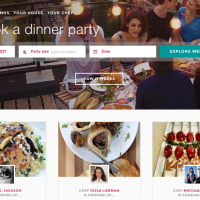Guest post by Brian Witlin, COO at Yummly. The views expressed here are solely those of the author, and do not reflect the views of Food+Tech Connect.
This is part II of III of of a 3 part series on venture capital fundraising. Click here to view part I.
4. Product and Company Strategy: What You’re Building
Many founders are great at thinking big and have a clear vision of where their startup will be in five years and billions of dollars later. What makes the difference is whether you have a strong product/company strategy to tactically get there. One worthwhile exercise is to lay out a release roadmap of key initiatives (by quarter). Ask yourself, is there logic to the staging of the company and product initiatives? Are key metrics assumptions, resourcing, and value appreciation milestones baked into the plan? This will further substantiate your raise amount and your financial assumptions. Here are some more questions to challenge you on this subject:
- How are you prioritizing efforts and initiatives over this year? Next?
- How are these priorities laid out over time? What is your high-level release plan?
- What initiatives/metrics are most critical to the success of the business?
- What initiatives/metrics are not critical to the success of the business?
5. Acquisition and Activation: If You Build It, How Will They Come?
You may have the best product in the world, but unless you can convince people to use it, no one will care. Having a clear strategy for driving acquisition and activation is critical to getting users in an efficient manner. Don’t worry if you don’t know exactly how you plan to get to 10 million users. What’s important is that you have a clear sense of how you are chipping away at the challenge by showing metrics focusing on optimization of visits, then signups, then active users, and eventually monetize-able users.
Be able to easily explain the logic of your process in order to reassure investors. And you should have your current metrics locked in your mind to show you are on top of your data. Here are some questions you will hear on the subject:
- What is the % of traffic by each major source?
- What is your registration rate?
- What is the total number of registrations by month and all time?
- What is the % traffic growth month over month? Year over year?
- What are your current efforts to increase traffic diversity, registration rate, and growth?
- What is the short-term (0-6 months) and mid-long term (6-18 months) impact on acquisition metrics?
- Be able to speak to deliberate efforts to drive acquisition during the last year: What initiatives did you employ? What made you successful? Why can you apply this talent to further improve this metric?
- How does platform expansion efforts play a part here? Is there risk of cannibalization? How will you mitigate?
6. Engagement: What Will People Do With Your Product Once They Arrive?
Do you have 5 million visitors who only visit one page and bounce, or do you have 10 thousand rabid users whose visits last more than 28 minutes per session? Each product/company has different ways they engage users and the optimization of your product can vary. Talk about how you engage your users to maximize value. Value can be calculated in a variety of ways (user utility, lifetime value, revenue/visit). Describe what engagement you are optimizing for, where you are today, and how you will continue to optimize this metric. Here are some questions you can expect:
- What are your page views per visit broken down by source?
- What are your current efforts to increase engagement + expected short-term (0-6 months) and mid-long term (6-18 months) impact?
- Be able to speak to your deliberate efforts to drive engagement during the last year: What initiatives did you employ? What made you successful? Why can you apply your talent to further improve this metric?
7. Retention: After They Have Come and Gone, Will They Return?
Investors tend to have an interest in the lifetime value of your users. For many companies, the more the user visits, the more that can be made. If you are paying for users, ideally you can show that you make more per user than you spend to acquire them. Nonetheless, knowing how you measure retention and a grasp on your plans to improve this metric (in relation to your lifetime user value) will help you greatly on the topic of retention. Here are some questions to test your knowledge:
What is your daily active users / monthly active user ratio for both registered cohort and all visitors? (many VCs have jumped on the bandwagon and ask this question because Andrew Chen mentioned it on Techcrunch).
- For your registered user cohort, how often do people come back?
- How many active users do you have?
- How do you define “active users”?
- Can you describe in detail the demographics/behavior of your active users?
- What is the average lifetime pageviews/visitor? For active users?
- What is your metric for retention? (Different companies measure this differently)
- What are your current efforts to increase retention?
- What is your expected short-term (0-6 months) and mid-long term (6-18 months) impact on retention?
- Be able to speak to our deliberate efforts to drive retention during this year: What initiatives did you employ? What made you successful? Why can you apply your talent to further improve this metric?
Stay tuned for Part III of III where I discuss revenue, funding needs, and knowing yourself.
is post originally appeared on LinkedIn on September 4, 2014.
________________
 Brian Witlin is the Chief Operating Officer (COO) of Yummly. Brian is a serial entrepreneur and design leader who has co-founded and led three companies to successful acquisitions.Brian currently heads all mobile and platform expansion initiatives at Yummly, the fastest growing digital foodtech startup where he launched the #1 iOS recipe app and the leading recipe API platform.
Brian Witlin is the Chief Operating Officer (COO) of Yummly. Brian is a serial entrepreneur and design leader who has co-founded and led three companies to successful acquisitions.Brian currently heads all mobile and platform expansion initiatives at Yummly, the fastest growing digital foodtech startup where he launched the #1 iOS recipe app and the leading recipe API platform.
Prior to his tenure at Yummly, Brian served as the CEO and Founder of ShopWell, the first truly personalized nutrition resource (acquired by YottaMark).
Brian holds a Lecturer position at Stanford University’s Hasso Platner Institute of Design, serves as a startup mentor at 500 Startups and works with a portfolio of startups and IDEO’s Entrepreneurship Initiative. He has also formerly held EIR (Entrepreneur in Residence) positions at IDEO and StartX. He writes on the subject of entrepreneurship and startups on his blog DesignDoing and guest writes on occasion on VentureBeat.
Previously, Brian co-founded Golaces, LLC, a product company (acquired by a publicly traded footwear company) and LeverWorks, a software development consultancy (acquired by LEO Media – now Quasar Strategies).
Brian holds a M.S. in Engineering and Design from Stanford University and a B.S. in Business and Economics from Lehigh University. He is a classically trained artist/draftsman, an aspiring mixed martial artist, and has a love for his hometown Chicago-style hotdogs and deep-dish pizza.






